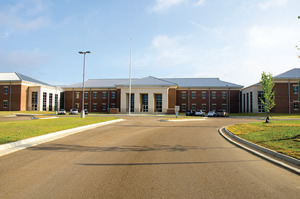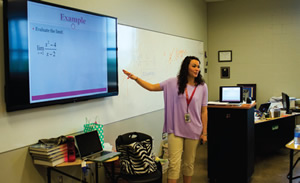Going Green on a Budget
- By Gwenn McDaniel
- 08/01/14

PHOTOS COURTESY OF JOHNSON CONTROLS
Oxford High School Principal Mike Martin said the first thing his 1,000 students noticed about the new high school they occupied early this year in Oxford, Miss., was the size of the classrooms and hallways.
“It’s like night and day, this building is at least three times the size of our previous school,” he says. “That means less crowding and less bumping into one another.”
What may not be as obvious to the Oxford High students are upgrades to the school’s heating, air conditioning, lighting and building management systems that are expected to save the school district more than $6 million over the next 15 years through energy savings and reduced operational costs.
Those savings became vital to the district’s plans to fund an integrated technology environment that included additional learning tools and security systems — all improving the safety, productivity and comfort of students, faculty and staff.
Oxford School District Superintendent Brian Harvey says energy efficiency was an important component of the school plan as far back as five years ago when early facility designing began.


PHOTOS COURTESY OF JOHNSON CONTROLS
Bigger And Better. Oxford High School, the 1,000-student, new high school in Oxford, Miss., is three times the size of the facility it replaces, but so much more efficient that it is expected to save the district more than $6 million over the next 15 years through energy savings and reduced operational costs. Those savings allowed the district to fund an integrated technology environment that includes additional learning tools and security systems, which has improved the safety, productivity and comfort of students, faculty and staff. The school is on track to become the first Mississippi high school to be LEED-Silver Certified.
“The new high school was designed and built with the foresight to make it the most technology-rich learning environment for our students and environmentally friendly for our community and school population,” he says. “That’s what we had in mind all along.”
While the vision for an energy-efficient school may have originated from the school district, its implementation came about through a partnership between Eley Guild Hardy Architects, Yates Construction and Johnson Controls.
Johnson Controls converged the many disparate building systems into a single networking solution to lower the district’s initial construction costs and decrease long-term operational and utility expenses. The single network also saved critical district resources by eliminating the need to manage multiple, duplicate or discrete systems under various vendors, contracts and proprietary protocols.
“Students probably don’t notice that the security and fire alarm systems now talk to each other, which is keeping them safer,” says Cheryl Aquadro, area general manager for Johnson Controls. “Inside the classroom, a network connects flat screen TVs, computers and handheld devices to help teachers inspire students. Even the clocks are now synchronized.”
Martin says his faculty and staff are impressed by the environmental systems’ ability to maintain a consistent temperature throughout the entire two-story, 220,000-square-foot facility. He says he frequently heard complaints of being either too hot or too cold in the previous high school building.
The new school’s lighting system includes motion sensors in each classroom and office. When a person walks into a dark room the lights turn on.
The design of the modular central energy plant that powers the school also helped keep construction costs below average and will keep ongoing maintenance costs to a minimum.
Oxford High is also on track to become the first Mississippi high school to be LEED silver certified. The building’s environmental systems meet LEED requirements for acoustic performance in core-learning spaces, such as classrooms, the media center, gymnasium and cafeteria.
“I’m very conscious of our energy savings and obtaining LEED certification,” Martin says. “Energy efficiency is very important to the students. It’s a big deal for them to come every day to a building that practices sustainability.”
Compared to the previous school building, the anticipated energy reduction at the new Oxford High would annually power 200 homes. Its reduced greenhouse gas emissions will be equivalent to the carbon withdrawn by 537 acres of pine forest.
“The new Oxford High School is a role model for sustainability,” says Superintendent Harvey.
The school was still in design and construction phases in December 2012 when district administrators were shaken by the tragedy at Sandy Hook Elementary School. They made a request for an access control system that was not part of the original budget. The request left the architectural, construction and building systems teams scrambling, according to Tim Prewitt, the self-described “clerk of the works” for Eley Guild Hardy Architects.
“We needed some funding help to get the district what it wanted,” he says. “This is where an energy services agreement and the resulting savings really made a difference. We got the access control system — and more — into the project.”
Security and energy efficiency can also go hand-in-hand. For example, the access control system can alert school staff to an open door — an invitation to criminals as well as an outlet for heated or chilled air to escape.
Along with access control, the school’s security solutions also include 100 video surveillance cameras and burglar alarm and fire safety systems. Panic buttons are available to immediately contact local first responders in case of an emergency.
Creating a high-tech learning environment was also important to district officials. The school’s network provides Wi-Fi capability throughout the facility. Each classroom has a 70-inch LCD monitor, while 60-inch monitors mounted in hallways keep students updated on school events and the cafeteria menus. This fall, as part of the school district’s One to One Digital Learning Initiative, every high school student will have a personal learning device, a MacBook Air laptop, in their hands.
Other notable features of the new campus include a salad bar in the cafeteria, an outdoor amphitheater and a courtyard where students and staff can enjoy lunches and between-class breaks.
A 2011 community bond referendum paid for the majority of the $30-million construction costs of the new school.
Martin says the past fall semester was busy planning the move that took place immediately following the winter holiday break. And the spring semester was all about settling into the new facility.
“It will probably hit next school year before we really appreciate all we have in this new school,” he says. “But we know we now are able to comfortably and safely prepare our students for the digital world whether they are going onto college or entering the workplace.”
This article originally appeared in the issue of .